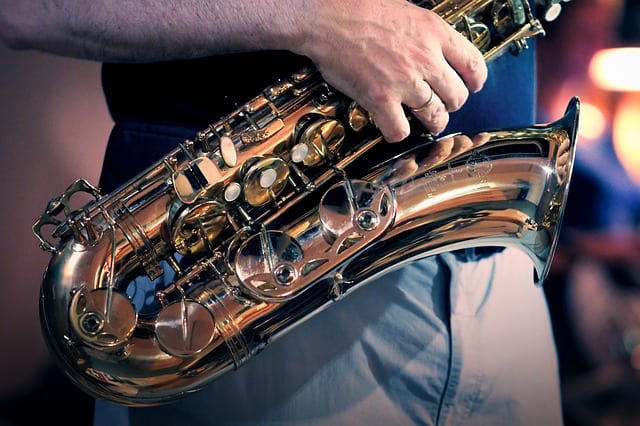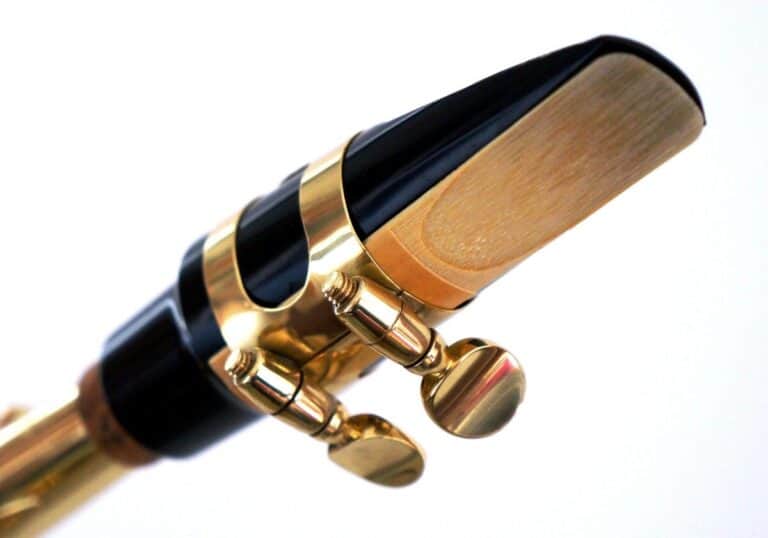Tenor Sax vs Alto Sax: Similarities & Differences
There are four main varieties of saxophone – the soprano, the alto, the tenor, and the baritone. I’ve been a saxophonist for a long time, and I’ve had the pleasure of playing all four of these a fair amount. The ones that I’ve played the most (and enjoy playing the most) are the tenor and alto saxophones.
I started out playing alto sax, but over the years I was eventually required to play the tenor sax as well to fill a spot in a jazz band. Some people might find it burdensome to have to play more than one instrument, but I found it to be a thrill.
After years of hauling my two saxophones around high school and college campuses (sometimes at the same time) for various band rehearsals, I often got questioned as to what exactly the difference between them is. So, that’s the question which I’m aiming to answer today.
Size
The main difference between the two instruments is that the tenor saxophone is larger and heavier, whereas the alto is smaller and lighter. The difference in size means that the tenor saxophone also plays lower notes and generally sounds darker than the alto.
I started playing the alto sax when I was a fifth-grader, and at the time the weight of the instrument felt heavy and burdensome, though not unmanageable. When I got into high school and had to start playing the tenor sax, I found the substantial increase in size and weight to be somewhat exhausting. It still wasn’t unmanageable, but it definitely took some getting used to.
As an adult, I no longer have much issue carrying and holding either of the instruments. Up until college, however, it still caused me a bit of difficulty. Granted, I happen to be a somewhat small person.
Hand size can also be an issue for larger saxophones such as the tenor. I didn’t have too much of a problem with this because I first played the tenor in high school, at which point my hands were more than large enough. Had I started playing the tenor saxophone in fifth grade, however, this might have been a problem for me.
Its larger size means that the tenor sax also plays lower notes and produces a darker sound than the alto sax. The larger the instrument, the lower it often plays.
Jazz
The tenor and alto saxes are treated differently in jazz in that the tenor sax plays the harmony while the lead alto plays the main melody. The tenor saxophone tends to be more popular than the alto for soloists, so if you are interested in jazz solos and improv then you may want to try the tenor sax.
The tenor and alto saxes have different roles in jazz, so which one you’ll want to play should depend on which role you are more interested in.
In a typical jazz band, the lead alto saxophone is the one that gets heard above all the other saxophones (and sometimes above all the other instruments in general). It’s one of the highest voices in the jazz band, so listeners are naturally drawn to listen to it. The part it plays is called the melody, or the part of the music which is the most satisfying to listen to and which can stand by itself.
If you are interested in playing the most important part of the music in a jazz band, then you will probably want to play the alto sax (particularly as the lead player). The alto is a critical instrument in the saxophone section, and the sound just isn’t the same without it. I’ve had the pleasure of playing lead alto in a jazz band a few times, and it can be a fun and musically rewarding experience.
In contrast, the tenor sax tends to play the harmony. The role of the harmony is to support the melody. The tenor sax generally won’t be the loudest or most noticed instrument in the saxophone section. The parts that the tenor sax often plays in a jazz band will sound strange if it’s just played by itself – only when the entire saxophone section is playing will it sound good.
So, you should keep in mind that you are signing up for more of a support role if you are playing tenor saxophone in a jazz band.
In smaller jazz ensembles, however, the tenor saxophone is more popular than the alto. Lots of people like the tenor sax as a soloist instrument, and you may be asked to play the tenor sax if you’re playing with just a small handful of other musicians. In these kinds of settings there’s a large emphasis on jazz improvisation, and you can count on about half of what you play being improv solos.
If you aren’t as interested in playing in big bands as you are in small jazz ensembles with fewer than ten or so musicians, then you may find the tenor sax to be more appealing. Keep in mind that both the tenor and alto saxes can excel in these settings, though, so don’t feel pressured to play the tenor sax purely to play in small ensembles.
Sound
The alto and tenor saxophones differ in the color of their sounds. The tenor saxophone has a sound which is darker and lower than the sound of the alto saxophone. The alto saxophone is higher, brighter, and can be heard more easily over other sounds.
Given that both the tenor and alto saxophones are in the same family of instruments (that is, the saxophone family), they have a fairly similar sound. I’ve always thought that the tenor sax had a warmer sound to it, whereas the sound of an alto sax is brighter and can be heard over everything.
It is hard to put a sound into words, so the best way to learn to tell the difference between the two is to listen to them.
I’ve included some links below of both saxophones soloing. Both samples are solos from the jazz piece All The Things You Are, so they are reasonably comparable.
Tenor saxophone:
Alto saxophone:
Difficulty
The tenor and alto saxophones are about equally difficult. The tenor saxophone is larger and harder to carry, but the alto saxophone requires you to have better control over your embouchure in order to sound good. The difficulties balance out, but both are easy to get started with.
For most band instruments, it takes some time to learn to produce a sound. On the saxophone, getting started is incredibly easy. Even as fifth graders, neither I nor any of my peers at the time struggled to get a sound out of their saxophone. I don’t think any of us were particularly talented. At the very least, I certainly wasn’t. If I as a fifth grader could get a sound out of the saxophone, then I’m willing to bet that you can too.
Of course, you are probably more interested in how difficult the tenor sax is compared to the alto. Even though the two instruments clearly have some differences, I still think that they are about equally difficult (or rather, equally easy). What difficulties exist just happen to be different for each instrument.
Tenor sax difficulties
The difficult part about the tenor saxophone is its size and weight. As I mentioned earlier, I struggled with the weight of the tenor sax even as a high schooler. I don’t think I personally could have handled it as an elementary schooler, though admittedly I’ve always been a somewhat small person.
The larger size of the tenor sax also means that you’ll need hands large enough to play it. My hands were more than large enough by the time I got into high school (and my hands happen to be fairly small), but if I had tried to play the tenor sax as a child I likely would have struggled. Having hands that are large enough to reach all the keys is pretty much a necessary requirement to playing the saxophone. There really isn’t any way around it.
Also, the tenor saxophone requires more air than the alto saxophone. It’s a larger instrument, and larger wind instruments require more lung power to get the air all the way through. It isn’t a big difference, though, so it shouldn’t be too much of a problem.
Alto sax difficulties
The difficult part about the alto sax is that the mouthpiece is smaller, and so the sound is more difficult to control. In general, a smaller mouthpiece means that the sound of the instrument is less stable. Developing a high-quality sound on the alto sax will take more work than developing a high-quality sound on the tenor sax.
In practice, this is a very minor problem. As a beginner you shouldn’t be concerned too much about the quality of your sound; any sound is fine at first so long as it can be heard. It is sometimes said that the saxophone sounds like a “sick goose” at first. I certainly went through this phase myself, and many saxophonists I know did so as well.
Which should I learn first?
The alto sax is better to learn for complete beginners than the tenor sax. Of the two, the alto’s smaller size means that it is more accessible to everyone even if you have small hands or can’t carry as much weight. The alto sax is also less expensive to play, with each alto sax reed costing half as much as a tenor sax reed.
Even though I think the two instruments are of about the same difficulty, I usually like to recommend that they learn the alto sax first.
This isn’t absolutely necessary; if you really want to play the tenor sax then you should just start on the tenor sax. However, it is much easier to get accustomed to the weight and size of an alto sax first than it is to jump straight to the tenor. It’s a bad idea to try to go for an instrument that you might not be able to handle.
The cost can also be a major consideration. The alto sax is simply cheaper to play than the tenor sax. The instrument itself is cheaper because it’s smaller, and the same goes for the mouthpieces and other equipment.
For instance, alto sax reeds are cheaper than tenor sax reeds. If you buy Vandoren reeds (which I personally recommend), you’ll get ten reeds if you buy an alto sax box. You only get five if you buy a box of tenor sax reeds. The boxes are close to the same price, and the cost adds up.
That being said, it is much more important to play an instrument that you want to play. I’ve personally tried playing instruments that I wasn’t entirely enthusiastic about, and it was always a struggle regardless of whether the instrument was technically difficult or not.
Conclusion
I’ve been playing saxophone for a long time, and I’ve gotten a lot of thrill from playing both the alto and the tenor sax. Personally, I’d wish for nothing more than for other people to be able to have the same kind of fun with it that I’ve had.
So, I hope this article has helped you learn more about the differences between the two saxophones, especially if you are considering learning one yourself!







